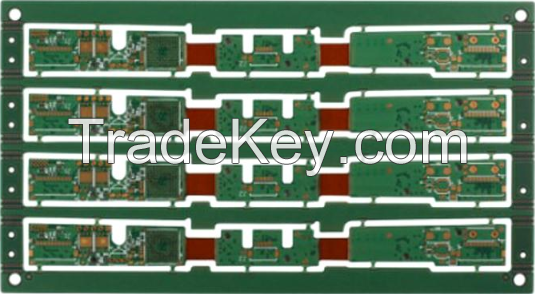|
ITEM
|
SPEC.
|
|
LAYER
|
10LAYER [FLEXIBLE 4L + RIGID 6L] 10-4-10
|
|
Application
|
GPS
|
|
Thickness
|
1.6T
|
|
Machine Drill
|
Min. 0.2mm
|
|
Laser Drill
|
BVH Min. 0.1mm
|
|
Cu Plating
|
HOLE Min. 25㎛
|
|
L/S
|
100㎛/100㎛
|
|
PSR
|
GREEN
|
|
Surface treatment
|
ENEPIG, ENIG
|
|
Impedance LAYER
|
1L, 4L, 8L, 10L
|
|
Impedance spec
|
50 Ω / 100 Ω
|

Description
'Rigid-Flex circuit board is the advanced
technology'
Design Capability
As printed circuit board technologies improve and electronics
continue to get smaller and smaller, you need to make sure your
current circuit board supplier has the appropriate equipment
needed for the specialty processes that are found in more
advanced circuit board designs. If your application requires a
complex multi-layer board with fine lines and traces having
plug via requirements, then we got you covered.
Our advanced multilayer Rigid-Flex circuit technology allows
for designers to sequentially add additional pairs of layers to
form a multilayer PCB up to 20 layers. JinSung Electronics has
been very specialized and is a leading company over Rigid-Flex
circuit globally, and we have supplied up to 20 layers R-Flex
circuit boards to more than 50 customers since 2015.
The Rigid-Flex circuit board is a board consisting of a rigid
part (non-bending part) and a flex part (bending part), and 3D
circuit connection is possible by flexing the flex part. In
addition, it has a bendability of up to 150,000 consecutive
bends, and it is advantageous for miniaturization and weight
reduction because there is no need for a connector for
connection between modules.
In addition, it is possible to maximize the space utilization
in the set with high design freedom, and a structural design
with high density, thinness, and various floors is also
possible.
Major application fields : Smartphones, tablets, laptops,
wearables, display modules, camera modules, etc.
What core technology JinSung has for developing HDI circuit
board?
What is the HDI PCB?
HDI PCB is the Abbreviation of high-density interconnect
printed circuit board, a kind of printed circuit board
manufacturing technology. An HDI PCB is a circuit board with a
relatively high circuit density that uses micro-blind and
buried "via"—or the copper-plated holes in PCBs—technology.
HDIs are compact products designed for small-capacity users, as
they cost much more than standard PCBs.
HDI PCB boards, one of the fastest growing technologies in the
PCB industry, are now available at JinSung Electronics. HDI
PCBs contain both the blind via and buried via hole varieties
and have a higher circuitry density than traditional circuit
boards.
What is the JinSung's capability to develop HDI
PCB?
A microvia maintains a laser-drilled diameter of, typically,
0.006" (150µm), 0.005″ (125µm), or 0.004" (100µm), which are
optically aligned and require a pad diameter of typically
0.012" (300µm), 0.010" (250µm), or 0.008" (200µm), allowing
additional routing density. Microvias can be via-in-pad,
offset, staggered or stacked, non-conductive filled and
copper-plated over the top, or solid copper filled or plated.
Microvias add value when routing out of fine-pitch ball grid
arrays (BGAs) such as 0.8 mm pitch devices and below.
Additionally, microvias add value when routing out of a 0.5 mm
pitch device where staggered microvias can be used. However,
routing micro-BGAs such as a 0.4 mm, 0.3 mm, or 0.25 mm pitch
device, requires the use of Stacked MicroVias using an inverted
pyramid routing technique.
What are HDI PCB Advantages?
1. HDI technology can reduce the cost of PCB, although when the
density of PCB increases beyond eight layers, it will be more
expensive to manufacture with HDI.
2. Have better electrical performance and signal
accuracy
3. Better reliability
4. Can improve thermal properties
5. Can improve radio frequency interference/electromagnetic
wave interference/electrostatic discharge
(RFI/EMI/ESD)
6. Greater design efficiency
Certifications and Patents






